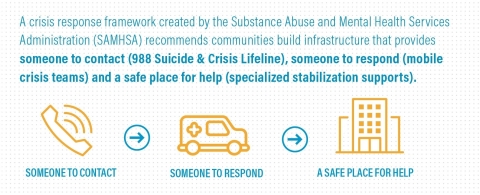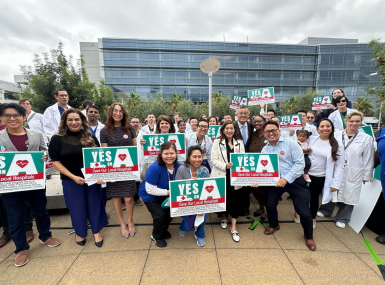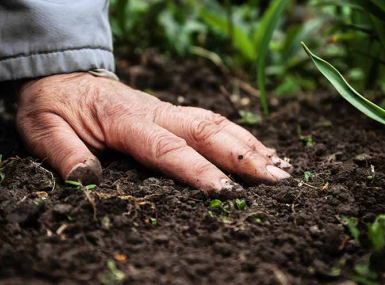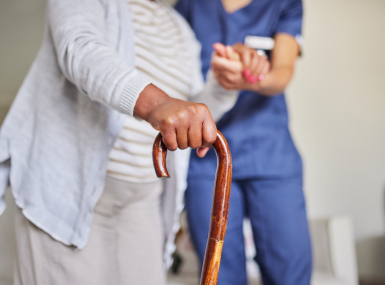County Funding Opportunities to Support Community Members Experiencing a Behavioral Health Crisis

Upcoming Events
Related News
County and local officials play a critical role in funding, implementing and coordinating a local continuum of care to support people during a behavioral health crisis. Counties allocate $100 billion annually to community health systems – including behavioral health support – and provide services through 750 behavioral health authorities and community providers. To inform local decision making, the National Association of Counties (NACo) and the National Association of County Behavioral Health and Developmental Disability Directors (NACBHDD) developed a chart of funding opportunities across federal, state and county governments and non-government sectors. Counties can blend and braid these resources to build a robust, accessible and sustainable behavioral health crisis continuum of care.
This funding chart can help county leaders identify possible funding streams to build and strengthen local behavioral health crisis response continuums. The funding sources reflect opportunities across behavioral health, criminal legal and related systems. Due to the cross-sector nature of crisis response, some sources focus on certain populations, like youth, while others target a certain supportive piece of the crisis continuum, like workforce or training.
Introduction
County and local officials play a critical role in funding, implementing and coordinating a local continuum of care to support people during a behavioral health crisis. Counties allocate $100 billion annually to community health systems – including behavioral health support – and provide services through 750 behavioral health authorities and community providers. To inform local decision making, the National Association of Counties (NACo) and the National Association of County Behavioral Health and Developmental Disability Directors (NACBHDD) developed a chart of funding opportunities across federal, state and county governments and non-government sectors. Counties can blend and braid these resources to build a robust, accessible and sustainable behavioral health crisis continuum of care.
This funding chart can help county leaders identify possible funding streams to build and strengthen local behavioral health crisis response continuums. The funding sources reflect opportunities across behavioral health, criminal legal and related systems. Due to the cross-sector nature of crisis response, some sources focus on certain populations, like youth, while others target a certain supportive piece of the crisis continuum, like workforce or training.
The Behavioral Health Continuum of Care

The three elements of the continuum of care – Someone to Talk To, Someone to Respond and A Safe Place for Help – are outlined in the National Guidelines for Behavioral Health Crisis Care, a roadmap to develop a robust array of services.
Someone to Talk To
The first part of a crisis continuum includes 24-hour staffed crisis call centers that provide immediate care and resources for individuals experiencing a behavioral health emergency. These call centers are equipped to take all calls/texts/chats, triage the immediate concern to assess additional needs and coordinate connections to care.
Someone to Respond
The second part of a crisis continuum includes mobile crisis teams (MCTs). Sometimes called crisis response teams or units, MCTs are community-based, face-to-face interventions that provide the least restrictive services to a resident wherever they are physically located. MCTs provide stabilization and treatment as well as deflect individuals away from the criminal legal system and emergency departments. These teams can include a combination of behavioral health clinicians, paramedics, peer support specialists, social workers and/or trained law enforcement.
A Safe Place for Help
The third part of a crisis continuum includes crisis receiving and stabilization centers that offer a different level of treatment than the options available over the phone or through an MCT when experiencing a behavioral health emergency. While the design and details vary, these centers often provide community members with access to out- and in-patient services, peer support networks, withdrawal management, medication adjustment, counseling, therapy and/or longer-term residential care. Many centers offer a dedicated first responder drop-off area and accept referrals and walk-ins.
How to Use the Chart
The chart is categorized by five types of funding sources: federal, state, federal/state and county governments and non-government sectors. The federal funding section is further broken out by federal agency. These sources may provide direct or pass-through funding to counties. Each source is accompanied by a summary, potential uses across the continuum – Someone to Talk To, Someone to Respond and a Safe Place for Help – and a county example where available.
Substance Abuse and Mental Health Services Administration (SAMHSA) | ||||||||||||||||||||||||||||||||||||||||||||
|
Department of Justice (DOJ) | ||||||||||||||||||||||||||||||||
|
Department of Education | ||||||||
|
Health Resources and Services Administration (HRSA) | ||||||||||||||||||||
|
U.S. Department of Agriculture (USDA) | ||||||||||||
|
Other Funding | ||||||||
|
Funding Source | Summary | Potential Uses | County Example |
|---|---|---|---|
Medicaid | Medicaid is a public health insurance program jointly funded by the federal government and states. It can support a broad range of crisis-related services. | Someone to Talk To Someone to Respond A Safe Place for Help | Maricopa County, Ariz. (Pop. 4,420,568) braids funding from the Regional Behavioral Health Authority and Arizona Medicaid to deploy mobile crisis teams and a “no-wrong-door” approach at local crisis triage centers. Doña Ana County, N.M. (Pop. 219,561) is using Medicaid funding to expand mobile crisis teams dispatched via 988. |
Funding Source | Summary | Potential Uses | County Example |
|---|---|---|---|
State cell phone fees | The federal legislation that created 988 and extended the scope of the National Suicide Prevention Lifeline also allows for states to charge fees on phone bills to help fund these services. | Someone to Talk To | Kern County, Calif. (Pop. 909,235) is one of 13 call centers in California that will benefit from comprehensive state legislation that established an eight-cent surcharge for cell phone users. |
State appropriations | As part of the annual budget process, states can allocate funding to specific programs that counties can leverage. | Someone to Talk To Someone to Respond A Safe Place for Help | Charleston County, S.C. (Pop. 408,235) will be home to a new 988 backup center in 2023, funded by $2.6 million in grants and appropriations from the state legislature. Missoula County, Mont. (Pop. 117,922) is using $113,000 from the state County and Tribal Matching Grant funds to begin planning and renovating a space for the Crisis Receiving Center. |
State taxes | States can levy taxes on certain items or income brackets for services that counties may access. | Someone to Talk To Someone to Respond A Safe Place for Help | Sonoma County, Calif. (Pop. 488,863) uses funding from the state Mental Health Services Act, a one percent income tax on personal income in excess of $1 million per year, to fund its mobile support team. |
State bonds | A state bond represents the issuance of debt for a state to undertake long-term construction and development projects, which may enhance county services. | Someone to Talk To Someone to Respond A Safe Place for Help | Multnomah County, Ore. (Pop. 815,428) Commissioners leveraged a state commitment of $10 million in lottery bonds to help develop the $26 million Behavioral Health Resource Center. |
Funding Source | Summary | Potential Uses | County Example |
|---|---|---|---|
Millages | A millage is a tax levied based on the market value of a property. | Someone to Talk To Someone to Respond A Safe Place for Help | Washtenaw County, Mich. (Pop. 372,258) dedicates a portion of the voter-approved, county Public Safety and Mental Health Preservation Millage to support the 24/7 CARES hotline. East Baton Rouge Parish’s (La.) (Pop. 456,781) Bridge Center for Hope, a crisis stabilization center, is funded by a 2018 voter-supported property tax. |
Sales tax | A sales tax is imposed on the sale of goods and services. | Someone to Talk To Someone to Respond A Safe Place for Help | Kitsap County, Wash. (Pop. 275,611) dedicates a portion of the Treatment Sales Tax to support the Behavioral Health Outreach Program. It provides law enforcement officers an option to request a navigator to assist with behavioral health calls. Larimer County, Colo. (Pop. 359,066) leaders are leveraging funding from the county’s 0.25 percent sales tax to fund a new behavioral health center. |
Bonds | A county or municipal bond represents the issuance of debt to undertake long-term construction and development projects. | Someone to Talk To Someone to Respond A Safe Place for Help | Dutchess County, N.Y. (Pop. 295,911) leaders, alongside local partners, funded the stabilization center with a $4.8 million bond in 2015. The center is anticipated to save taxpayers $950,000 in 2023. |
General funds | As part of the annual budget process, counties can allocate funding to specific programs. | Someone to Talk To Someone to Respond A Safe Place for Help | Johnson County, Kan. (Pop. 609,863) Commissioners allocated $170,000 to hire four full-time case managers to staff 988. Wood County’s (Ohio) (Pop. 132,248) Addiction Response Collaborative Quick Response Team is funded through the Wood County ADAMS Board, County Health Department and Ohio Attorney General’s Office. The team supports people during an overdose. |
Sheriff/police budgets | Sheriffs and police chiefs are investing funds from their own budgets in the behavioral health continuum of care to provide the treatment and services to people in need before they encounter law enforcement. | Someone to Respond A Safe Place for Help | The St. Mary’s County’s (Md.) (Pop. 113,777) Sheriff’s Office hired a mental health liaison to support law enforcement officers responding to mental health calls. Sebastian County, Ark. (Pop. 127,799) will establish and operate a sobering center by leveraging $100,000 from a local police department and $675,000 in ARPA Recovery Funds. |
Funding Source | Summary | Potential Uses | County Example |
|---|---|---|---|
In February 2022, a $26 billion multi-district settlement resolved a manufacturer’s and three distributors’ liabilities in over 3,000 opioid crisis-related suits nationwide. Over the next two decades, local governments will receive settlement funds for prevention, treatment and recovery efforts to be used primarily for opioid remediation strategies. | Someone to Talk To Someone to Respond A Safe Place for Help | Frederick County, Md. (Pop. 271,717) is opening a crisis stabilization center, using ARPA Recovery Funds and state grant funds, with ongoing operations funded through payments made from the opioid settlement. | |
Philanthropic organizations | Philanthropic organizations can help fund elements of the crisis continuum through direct gifts. | Someone to Talk To Someone to Respond A Safe Place for Help | Denver, Colo. (Pop. 715,522) received a $2.8 million grant from the Caring for Denver Foundation to add three mental health clinicians to the co-responder teams in the fire department and park rangers program. Richland County, S.C. (Pop. 416,147) received $200,000 from the Sozosei Foundation to add another co-responder team to the Law Enforcement and Behavioral Health Partnership. Pennington County, S.D. (Pop. 109,222) is leveraging a $4 million gift from the Helmsley Charitable Trust to fund operations at the crisis unit’s new facility for 36 months. |
Further Reading
- SAMHSA 988 Partner Toolkit
- Toolkit for Counties: 988 Suicide & Crisis Lifeline
- #ReimagineCrisis 988 Crisis Response State Legislation Map
- How County Elected Officials Can Support Crisis Triage Centers: A Place for Community Members to Go During a Behavioral Health Emergency
- Mental Health in Rural Communities Toolkit
- Rural Suicide Prevention Toolkit
- Rural Health Research Center Publications on Mental and Behavioral Health
- Violence and Abuse in Rural America Topic Guide
- Overview of Crisis Funding Sources Available to States and Localities
Acknowledgements
Support for this resource was provided by the Sozosei Foundation. The views expressed here do not necessarily reflect the views of the Sozosei Foundation.
This resource was researched and written by Jonah C. Cunningham, President and CEO of the National Association of County Behavioral Health & Developmental Disability Directors with support and guidance from Chelsea Thomson, Senior Program Manager, Behavioral Health and Justice at the National Association of Counties, and Naomi Seiler and Katie Horton from George Washington University.

Resource
Messaging to Support a Behavioral Health Continuum of Care: Intellectual and Developmental Disability Directors






